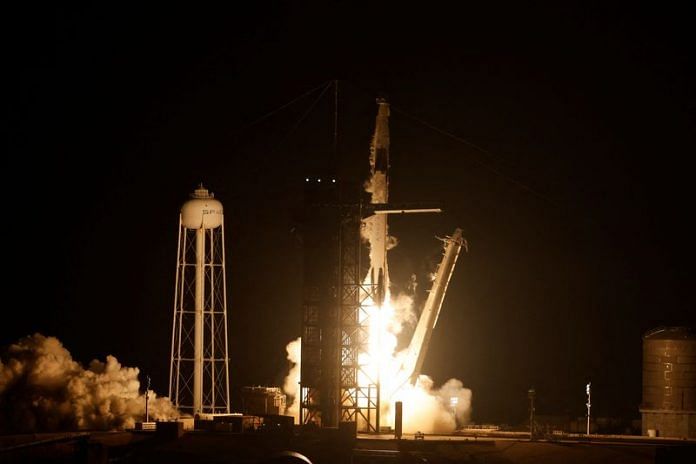Cape Canaveral, Florida: Elon Musk’s rocket company SpaceX launched a four-person crew on a trip to the International Space Station early on Thursday, with a Russian cosmonaut and United Arab Emirates astronaut joining two NASA crewmates on the flight.
The SpaceX launch vehicle, consisting of a Falcon 9 rocket topped with an autonomously operated Crew Dragon capsule called Endeavour, lifted off at 12:34 a.m. EST (0534 GMT) from NASA’s Kennedy Space Center in Cape Canaveral, Florida.
A live NASA webcast showed the 25-story-tall spacecraft ascending from the launch tower as its nine Merlin engines roared to life in billowing clouds of vapor and a reddish fireball that lit up the pre-dawn sky.
The launch was expected to accelerate the Crew Dragon to an orbital velocity of 17,500 miles per hour (28,164 kph), more than 22 times the speed of sound.
The flight came 72 hours after an initial launch attempt was scrubbed in the final minutes of countdown early on Monday due to a clog in the flow of engine-ignition fluid. NASA said the problem was fixed by replacing a clogged filter and purging the system.
The trip to the International Space Station (ISS), a laboratory orbiting some 250 miles (420 km) above Earth, was expected to take nearly 25 hours, with rendezvous planned for about 1:15 a.m. EST (0615 GMT) on Friday as the crew begins a six-month science mission in microgravity.
Designated Crew 6, the mission marks the sixth long-term ISS team that NASA has flown aboard SpaceX since the private rocket venture founded by Musk – billionaire CEO of electric car maker Tesla and social media platform Twitter – began sending American astronauts to orbit in May 2020.
The latest ISS crew was led by mission commander Stephen Bowen, 59, a onetime U.S. Navy submarine officer who has logged more than 40 days in orbit as a veteran of three space shuttle flights and seven spacewalks.
Fellow NASA astronaut Warren “Woody” Hoburg, 37, an engineer and commercial aviator designated as the Crew 6 pilot, was making his first spaceflight.
The Crew 6 mission also is notable for its inclusion of UAE astronaut Sultan Alneyadi, 41, only the second person from his country to fly to space and the first to launch from U.S. soil as part of a long-duration space station team. UAE’s first-ever astronaut launched to orbit in 2019 aboard a Russian spacecraft.
Rounding out the four-man Crew 6 was Russian cosmonaut Andrey Fedyaev, 42, who like Alneyadi is an engineer and spaceflight rookie designated as a mission specialist for the team.
Fedyaev is the second cosmonaut to fly aboard an American spacecraft under a renewed ride-sharing deal signed in July by NASA and the Russian space agency Roscosmos, despite heightened tensions between Washington and Moscow over Russia’s invasion of Ukraine.
The Crew 6 team will be welcomed aboard the space station by seven current ISS occupants – three U.S. NASA crew members, including commander Nicole Aunapu Mann, the first Native American woman to fly to space, along with three Russians and a Japanese astronaut.
The ISS, about the length of a football field, has been continuously operated for more than two decades years by a U.S.-Russian-led consortium that includes Canada, Japan and 11 European countries.
The Crew 6 mission follows two recent mishaps in which Russian spacecraft docked to the orbiting laboratory sprang coolant leaks apparently caused micrometeoroids, tiny grains of space rock, streaking through space and striking the craft at high velocity.
One of the affected Russian vehicles was a Soyuz crew capsule that had carried two cosmonauts and an astronaut to the space station in September for a six-month mission now set to end in March. An empty replacement Soyuz to bring them home arrived at the space station on Saturday.
(Reporting by Joe Skipper in Cape Canaveral and Steve Gorman in Los Angeles; Editing by Will Dunham)
Disclaimer: This report is auto generated from the Reuters news service. ThePrint holds no responsibilty for its content.
Also read: Technical glitch delays NASA-SpaceX launch of next space station crew






